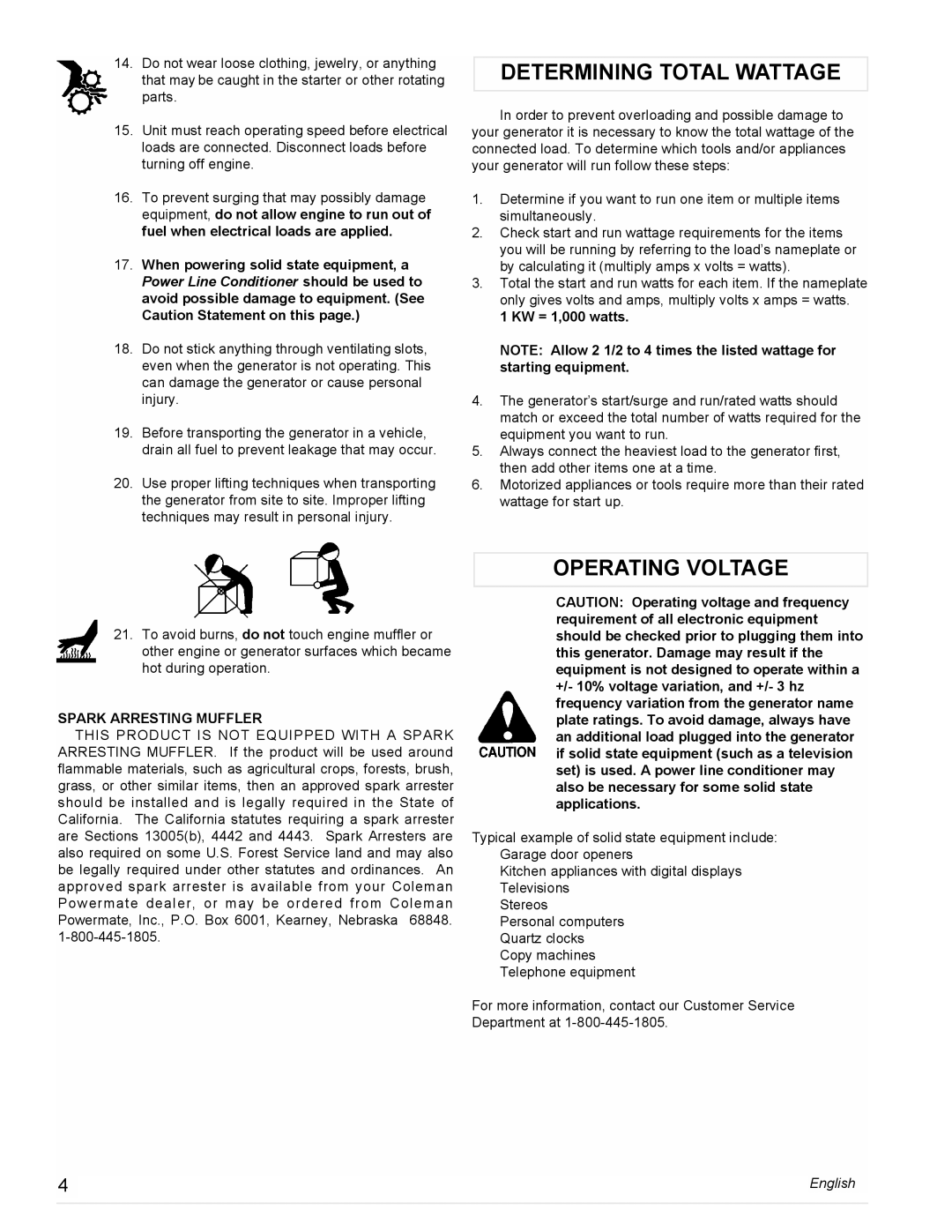
14.Do not wear loose clothing, jewelry, or anything that may be caught in the starter or other rotating parts.
15.Unit must reach operating speed before electrical loads are connected. Disconnect loads before turning off engine.
16.To prevent surging that may possibly damage equipment, do not allow engine to run out of fuel when electrical loads are applied.
17.When powering solid state equipment, a Power Line Conditioner should be used to avoid possible damage to equipment. (See Caution Statement on this page.)
18.Do not stick anything through ventilating slots, even when the generator is not operating. This can damage the generator or cause personal injury.
19.Before transporting the generator in a vehicle, drain all fuel to prevent leakage that may occur.
20.Use proper lifting techniques when transporting the generator from site to site. Improper lifting techniques may result in personal injury.
DETERMINING TOTAL WATTAGE
In order to prevent overloading and possible damage to your generator it is necessary to know the total wattage of the connected load. To determine which tools and/or appliances your generator will run follow these steps:
1.Determine if you want to run one item or multiple items simultaneously.
2.Check start and run wattage requirements for the items you will be running by referring to the load’s nameplate or by calculating it (multiply amps x volts = watts).
3.Total the start and run watts for each item. If the nameplate only gives volts and amps, multiply volts x amps = watts.
1 KW = 1,000 watts.
NOTE: Allow 2 1/2 to 4 times the listed wattage for starting equipment.
4.The generator’s start/surge and run/rated watts should match or exceed the total number of watts required for the equipment you want to run.
5.Always connect the heaviest load to the generator first, then add other items one at a time.
6.Motorized appliances or tools require more than their rated wattage for start up.
21.To avoid burns, do not touch engine muffler or other engine or generator surfaces which became hot during operation.
SPARK ARRESTING MUFFLER
THIS PRODUCT IS NOT EQUIPPED WITH A SPARK ARRESTING MUFFLER. If the product will be used around flammable materials, such as agricultural crops, forests, brush, grass, or other similar items, then an approved spark arrester should be installed and is legally required in the State of California. The California statutes requiring a spark arrester are Sections 13005(b), 4442 and 4443. Spark Arresters are also required on some U.S. Forest Service land and may also be legally required under other statutes and ordinances. An approved spark arrester is available from your Coleman Powermate dealer, or may be ordered from Coleman Powermate, Inc., P.O. Box 6001, Kearney, Nebraska 68848.
4
OPERATING VOLTAGE
CAUTION: Operating voltage and frequency requirement of all electronic equipment should be checked prior to plugging them into this generator. Damage may result if the equipment is not designed to operate within a +/- 10% voltage variation, and +/- 3 hz frequency variation from the generator name plate ratings. To avoid damage, always have an additional load plugged into the generator if solid state equipment (such as a television set) is used. A power line conditioner may also be necessary for some solid state applications.
Typical example of solid state equipment include: Garage door openers
Kitchen appliances with digital displays Televisions
Stereos
Personal computers Quartz clocks Copy machines Telephone equipment
For more information, contact our Customer Service Department at
